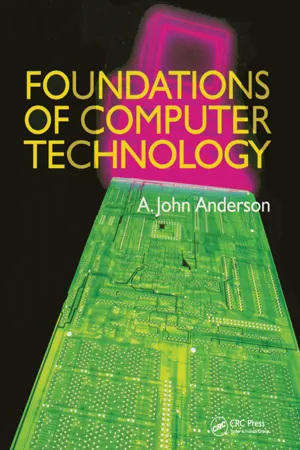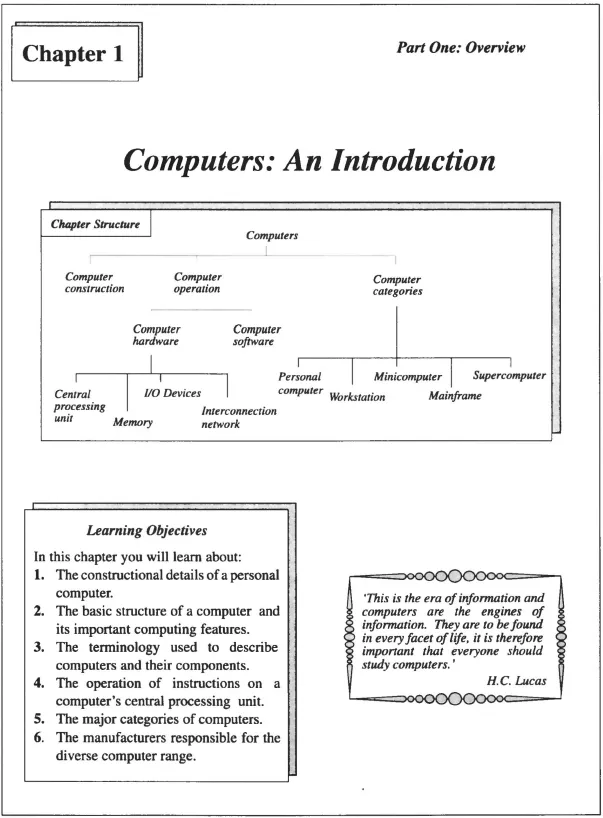
- English
- ePUB (mobile friendly)
- Available on iOS & Android
eBook - ePub
Foundations of Computer Technology
About this book
Foundations of Computer Technology is an easily accessible introduction to the architecture of computers and peripherals. This textbook clearly and completely explains modern computer systems through an approach that integrates components, systems, software, and design. It provides a succinct, systematic, and readable guide to computers, providing a springboard for students to pursue more detailed technology subjects.
This volume focuses on hardware elements within a computer system and the impact of software on its architecture. It discusses practical aspects of computer organization (structure, behavior, and design) delivering the necessary fundamentals for electrical engineering and computer science students.
The book not only lists a wide range of terms, but also explains the basic operations of components within a system, aided by many detailed illustrations. Material on modern technologies is combined with a historical perspective, delivering a range of articles on hardware, architecture and software, programming methodologies, and the nature of operating systems. It also includes a unified treatment on the entire computing spectrum, ranging from microcomputers to supercomputers.
Each section features learning objectives and chapter outlines. Small glossary entries define technical terms and each chapter ends with an alphabetical list of key terms for reference and review. Review questions also appear at the end of each chapter and project questions inspire readers to research beyond the text. Short, annotated bibliographies direct students to additional useful reading.
Frequently asked questions
Yes, you can cancel anytime from the Subscription tab in your account settings on the Perlego website. Your subscription will stay active until the end of your current billing period. Learn how to cancel your subscription.
At the moment all of our mobile-responsive ePub books are available to download via the app. Most of our PDFs are also available to download and we're working on making the final remaining ones downloadable now. Learn more here.
Perlego offers two plans: Essential and Complete
- Essential is ideal for learners and professionals who enjoy exploring a wide range of subjects. Access the Essential Library with 800,000+ trusted titles and best-sellers across business, personal growth, and the humanities. Includes unlimited reading time and Standard Read Aloud voice.
- Complete: Perfect for advanced learners and researchers needing full, unrestricted access. Unlock 1.4M+ books across hundreds of subjects, including academic and specialized titles. The Complete Plan also includes advanced features like Premium Read Aloud and Research Assistant.
We are an online textbook subscription service, where you can get access to an entire online library for less than the price of a single book per month. With over 1 million books across 1000+ topics, we’ve got you covered! Learn more here.
Look out for the read-aloud symbol on your next book to see if you can listen to it. The read-aloud tool reads text aloud for you, highlighting the text as it is being read. You can pause it, speed it up and slow it down. Learn more here.
Yes! You can use the Perlego app on both iOS or Android devices to read anytime, anywhere — even offline. Perfect for commutes or when you’re on the go.
Please note we cannot support devices running on iOS 13 and Android 7 or earlier. Learn more about using the app.
Please note we cannot support devices running on iOS 13 and Android 7 or earlier. Learn more about using the app.
Yes, you can access Foundations of Computer Technology by Alexander John Anderson in PDF and/or ePUB format, as well as other popular books in Computer Science & Computer Networking. We have over one million books available in our catalogue for you to explore.
Information
Overview |  |
Part One
Chapter 1 Computers: An Introduction
1.1 Computer construction
1.2 Computer operation
1.3 Computer hardware
1.4 Computer software
1.5 Computer categories
Parts | |
Part One: | Overview |
Part Two: | Hardware |
Part Three: | Software |
Part Four: | Operating Systems |
Part Five: | Networks |
Part Six: | Advanced Hardware |
Part Seven: | Appendix |

Chapter 1
Computers: An Introduction
This chapter presents an overview of computers, their construction and operation. It may be seen as an overture to the rest of the book in that it introduces the different hardware and software themes that will be developed in the later chapters.
In the four decades since the early 1950s the computer has emerged from being a large metal box performing mundane calculations to become a multifaceted machine capable, through various pieces of software, of being used in a myriad of different situations for a large number of jobs. In particular over the past 10 years we have seen an explosion in the use of information technology. Information technology may be seen as the organization, manipulation and distribution of information. It is dependent on the ability to process electrical signals at low cost, high speed and with operational reliability. The enabling technology which has brought about the current information explosion includes microelectronics, computation, signal processing and communications. As the activities encountered in information technology are central to almost every computer, the term is used to mean almost the same as computing.
In its most basic form a computer is essentially a machine that receives, stores, manipulates and communicates information. It does this by breaking a task down into logical operations that can be carried out on binary numbers (strings of 1 s and 0s) and doing millions of such operations per second. A computer is also an electronic system, usually constructed from digital integrated circuits (ICs) that can execute structures of logical operations given to it in a program. A computer system is designed at many levels ranging from its high level software structure down to the transistors in its hardware.
Computers derive their desirable properties from their speed and accuracy in performing complex calculations and in the fact that they possess a memory for retaining programs and data.
1. The speed of a computer is determined by the switching time of the electronic circuits within it and the distance the electric signals have to travel within the unit.
2. The accuracy of the computer results from the sophistication of the arithmetic circuits in the computer and on the repeatability with which it performs its operations. This in turn is due to the reliability of the electronic circuits that make up the system.
3. Computers derive their flexibility from the fact that they can be programmed, where a computer program may be seen as a series of instructions which direct the computer to perform a given task.
1.1 COMPUTER CONSTRUCTION
We will consider in more detail how a computer operates; however, before embarking on this investigation we will note the constructional details of a small desktop or personal computer (PC). The basic units within such a system (shown in Figure 1.1) are:

The basic units within a computer.
1. Visual display unit The computer requires a visual display unit (VDU) to output information and data to the operator. A VDU is similar to a conventional television in appearance. It is connected to the computer by a power cable and a data cable.
2. Keyboard The keyboard is used by the operator to enter commands and data into the computer. It is styled on a typewriter with extra keys and is connected to the computer by a cable.
3. A cabinet There are several styles of cases available for personal computers:
(a) Desktop, or table top
(b) Compact desktop, or mini desktop
(c) Mini–tower
(d) Normal size tower
(e) Laptops, notebooks, portables.
4. Chassis This is a frame constructed of metal and plastic that houses all the internal components of a computer. The computer also usually has a card cage which holds the printed circuit boards. The card cage has a number of backplane connectors wired together to form a bus.
5. Power supply Most computers use a 5 V direct current (DC) power supply. The power supply has a transformer, a rectifier, a ripple filter and a solid–state voltage regulator. Most modern personal computers come with a 200 W power supply. This is required to power the printed circuit board and all the system peripherals. An indication of the power consumption of various parts of a personal computer system is...
Table of contents
- Cover
- Half Title
- Title Page
- Copyright Page
- Dedication
- Table of Contents
- Preface
- Part One Overview
- Part Two Hardware
- Part Three Software
- Part Four Operating Systems
- Part Five Networks
- Part Six Advanced Hardware
- Part Seven Appendix
- Acronyms
- Index